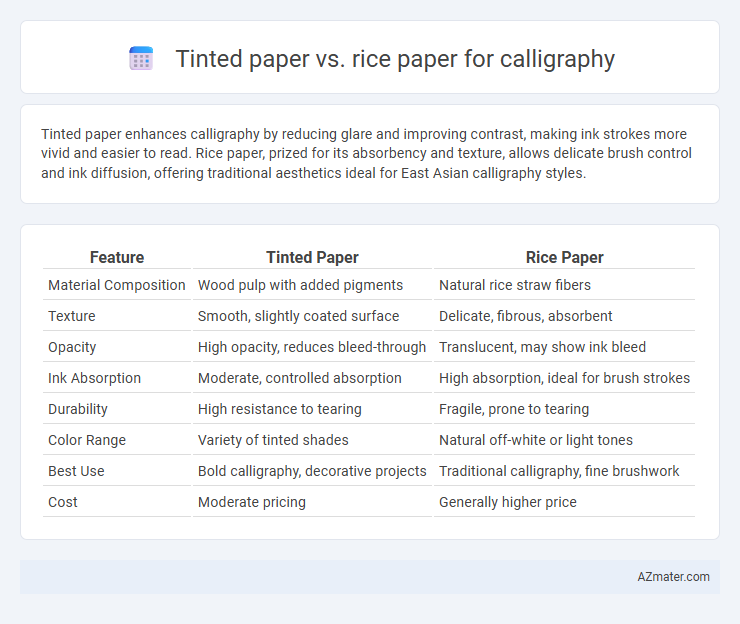Tinted paper enhances calligraphy by reducing glare and improving contrast, making ink strokes more vivid and easier to read. Rice paper, prized for its absorbency and texture, allows delicate brush control and ink diffusion, offering traditional aesthetics ideal for East Asian calligraphy styles.
Table of Comparison
| Feature | Tinted Paper | Rice Paper |
|---|---|---|
| Material Composition | Wood pulp with added pigments | Natural rice straw fibers |
| Texture | Smooth, slightly coated surface | Delicate, fibrous, absorbent |
| Opacity | High opacity, reduces bleed-through | Translucent, may show ink bleed |
| Ink Absorption | Moderate, controlled absorption | High absorption, ideal for brush strokes |
| Durability | High resistance to tearing | Fragile, prone to tearing |
| Color Range | Variety of tinted shades | Natural off-white or light tones |
| Best Use | Bold calligraphy, decorative projects | Traditional calligraphy, fine brushwork |
| Cost | Moderate pricing | Generally higher price |
Introduction: Understanding Calligraphy Paper Choices
Tinted paper offers a smooth, colored surface that enhances the visibility of ink strokes and adds a subtle background tone to calligraphy projects, making them visually striking. Rice paper, known for its delicate texture and absorbency, allows ink to spread softly, creating elegant, fluid lines ideal for traditional brush calligraphy. Selecting between tinted paper and rice paper depends on the desired aesthetic effect and the specific calligraphy technique being employed.
What Is Tinted Paper in Calligraphy?
Tinted paper in calligraphy refers to sheets that have been infused with subtle colors such as cream, pastel, or muted earth tones to enhance the visual appeal and contrast of ink strokes. This type of paper often features a smooth texture that supports fluid pen movement while preventing ink bleed-through, essential for crisp calligraphic lines. Compared to rice paper, tinted paper offers greater opacity and durability, making it preferable for projects that require long-lasting, vibrant presentations.
What Is Rice Paper in Calligraphy?
Rice paper, traditionally made from mulberry bark fibers, is prized in calligraphy for its absorbent texture and smooth surface, enabling precise ink flow and delicate brush strokes. Unlike tinted paper, which offers color variety to enhance visual appeal, rice paper emphasizes natural, high-quality material that preserves the authenticity of East Asian calligraphy art. Its lightweight durability and translucency make it ideal for both practice and final artwork in traditional Chinese, Japanese, and Korean calligraphy.
Texture Comparison: Tinted vs Rice Paper
Tinted paper features a smoother, more uniform texture that allows ink to flow evenly, making it ideal for clean, precise calligraphy strokes. Rice paper, known for its fibrous, slightly rough surface, provides a tactile response that enhances brush control and ink absorption, yielding natural variations in line thickness. The choice between tinted and rice paper depends on the desired effect: smooth consistency versus textured depth in calligraphy artwork.
Ink Absorption and Performance
Tinted paper offers moderate ink absorption, providing vibrant contrast and preventing excessive bleeding, making it ideal for detailed calligraphy work. Rice paper, known for its highly absorbent fibers, allows ink to spread smoothly but can lead to feathering and less control over fine lines. For optimal performance, artists choose tinted paper for precision and rice paper for expressive, fluid strokes.
Appearance and Aesthetic Impact
Tinted paper offers a rich, subtle background that enhances calligraphy by adding depth and warmth, making ink colors stand out vividly. Rice paper, known for its delicate texture and translucent quality, imparts an organic, traditional aesthetic that complements the fluidity of brush strokes. Both materials influence the visual harmony, but tinted paper emphasizes color contrast while rice paper highlights texture and authenticity.
Durability and Longevity
Tinted paper typically offers greater durability and longevity than rice paper because it is usually made from cotton or wood pulp fibers, which resist tearing and discoloration over time. Rice paper, while prized for its delicate texture and absorbency ideal for traditional calligraphy, is more prone to aging issues such as brittleness and yellowing due to its thin, fibrous composition. For calligraphy artworks intended to last, tinted paper provides a more stable surface that withstands environmental factors and handling better than rice paper.
Best Uses for Tinted Paper
Tinted paper enhances calligraphy projects by providing a subtle background that improves ink contrast and readability, making it ideal for invitations, certificates, and creative artwork. Its gentle hue adds visual depth and sophistication, perfect for formal documents or decorative pieces where a traditional white background might appear too stark. Compared to rice paper, tinted paper offers greater durability and smoother texture, facilitating clean, precise strokes with various ink types.
Best Uses for Rice Paper
Rice paper, known for its delicate texture and high absorbency, is ideal for traditional Chinese and Japanese calligraphy, allowing ink to flow smoothly and create sharp, expressive strokes. Its softness makes it perfect for brush work that requires precise control and vibrant contrasts, especially in sumi-e and shodo styles. Compared to tinted paper, rice paper excels in authenticity and archival quality, making it the preferred choice for professional calligraphers seeking longevity and artistic finesse.
Choosing the Right Paper for Your Calligraphy Style
Choosing the right paper for your calligraphy style significantly impacts the final artwork's texture and ink absorption. Tinted paper offers a subtle background that enhances contrast and visual appeal, ideal for brush and pointed pen calligraphy with smooth ink flow. Rice paper, known for its delicate and fibrous texture, suits traditional East Asian calligraphy, allowing for expressive brush strokes and controlled bleeding.

Infographic: Tinted paper vs Rice paper for Calligraphy
 azmater.com
azmater.com